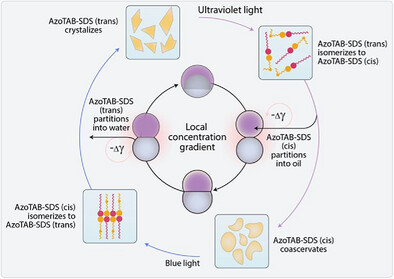Nuevo avance en materiales inteligentes: sistemas coloidales que cambian de forma con luz
Un equipo de investigadores del Grupo de Cristales Líquidos y Polímeros, del Instituto de Nanociencia y Materiales de Aragón, instituto mixto CSIC-UNIZAR, en colaboración con el Max Planck Institute of Colloids and Interfaces (Alemania), ha desarrollado un innovador sistema coloidal capaz de cambiar de forma de manera reversible y controlada mediante luz en apenas unos segundos. El trabajo ha sido publicado en la prestigiosa revista Advanced Materials.
El estudio presenta un nuevo mecanismo que permite a gotas (droplets) micrométricas comportarse como verdaderas «máquinas blandas»: pueden deformarse, moverse, dividirse o fusionarse en cuestión de segundos. Este comportamiento es posible gracias a una transición de fase reversible inducida por luz en mezclas de tensioactivos (surfactantes), que permite controlar con gran precisión la tensión interfacial de las gotas.
Este avance abre nuevas posibilidades para el desarrollo de materiales blandos (soft materials) inteligentes con amplias aplicaciones. Su rápida respuesta, completamente reversible y controlable con luz, los hace especialmente prometedores en campos como la robótica blanda, la liberación dirigida de fármacos o la manipulación dinámica de fluidos a escala microscópica.
Puedes consultar el artículo completo aquí: https://advanced.onlinelibrary.wiley.com/doi/10.1002/adma.202506100?af=R.
«Reversible phase transitions of anionic and cationic surfactant mixtures drive shape morphing droplets»
Bradley D. Frank, Pilar Romero, Alberto Concellón, Lukas Zeininger
26th June 2025
Abstract:
Converting chemical signals into mechanical responses is fundamental to biological systems, driving processes such as cellular motility and tissue morphogenesis. Yet, harnessing chemo-mechanical signal conversions in synthetic systems remains a key challenge in energy-dissipative materials design. While droplets can move and interact with their environment reminiscent of active biological matter, chemo-mechanical interactions are limited by the translation of chemical changes into extensive force variations required on small timescales. Droplets naturally adopt spherical shapes to minimize surface-energy and restructuring liquids into non-equilibrium geometries requires mechanisms beyond current stimuli-responsive surfactant systems, which lack the force-amplifying mechanisms needed for transient liquid structuring. Here, a spring-like charging and latch-controlled release mechanism is introduced for actuating droplets. This is based on reversible, light-induced crystal-to-coacervate phase transitions of photo-responsive surfactant assemblies, namely between anionic sodium dodecylsulfate and cationic azobenzene-based surfactants. During phase-transition, reversible partitioning of the surfactants into the oil or aqueous phases of the emulsion transiently induce rapid changes in interfacial tensions, which are up to 900 times greater than those observed for conventional stimuli-responsive surfactant systems. The insights into this novel chemo-mechanical transduction mechanism provide new control over purely liquid systems, paving the way for programmable, hierarchically structured, all-liquid matter acting with physicality.










